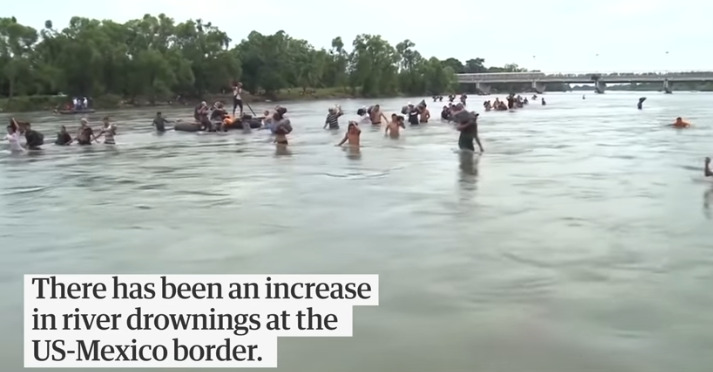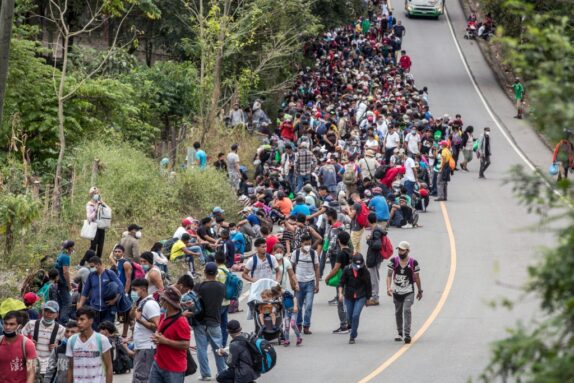Under the shroubling super cold wave in North America, the Rio Grande, which is the border between the United States and Mexico, has stopped many immigrants, making it impossible for some people to reach the United States.
On Wednesday (17th), the news spread again on the Rio Grande, an 8-year-old Honduran boy drowned while crossing the river. On the same day, the cold river also claimed the life of a Venezuelan woman who tried to cross the border.
According to the British Guardian on the 19th, the Mexican Immigration Service revealed the tragedy in a statement on the 18th.
According to the statement, the 8-year-old Honduran boy was trying to cross the cold river to Texas on the other side with his family on the 17th.
However, while crossing the river, the boy sank into the water for several meters because he could not resist the rough water.
Although the boy’s parents and sister successfully reached the other side, they were immediately arrested by the U.S. Border Patrol and sent back to Mexico by the U.S. Customs and Border Protection (CBP)
On the same day as the tragedy, the Mexican Immigration Service also announced that a Venezuelan woman had also died while crossing the river.
Three others encountered hypothermia during the crossing, two of them fled to the United States, and the rest were treated in the Mexican Red Cross.
The Rio Grande River is a river in southern North America, of which about 2,000 kilometers form the border between Texas and Mexico in the United States, which is the only way for many immigrants to the United States.
From the Mexican town of Piedras Negras on the other end of the river to the Texas border town Eagle Pass, only 120 feet (about 36.6 meters) away took the lives of many immigrants.


In a June 2019 report, the Guardian revealed that although it is not far away, the closer the river is to the shore of the United States, the greater its flow rate will be. Especially for some children, the depth of the chest-length water poses a great threat to them.
Once the immigrants return, they are likely to be repatriated by the Mexican authorities to the country of origin, which will make their migration journey abandoned. In this case, dozens of migrants drowned while crossing the river in the first half of 2019 alone.
Martha Sánchez Soler, head of the Mexican American Migration Movement, a non-profit advocacy organization based in Mexico City, said that immigrants who recently arrived in Mexico The number has increased significantly, and these immigrants are trying to live a better life.
However, due to the epidemic, Mexico does not have enough places to provide asylum for these immigrants.
They have to continue to the north in the harsh weather. With the super cold wave that has swept North America today, the journey of immigrants is full of deadly threats.
The Associated Press revealed on the 19th that Texas Border Patrol personnel have detained more than 200 illegal immigrants in the past week, all of whom have suffered from frostbite and other severe cold injuries.
The U.S. Customs and Border Protection said that these immigrants came from Mexico, Guatemala, El Salvador, Honduras and Ecuador.
The threats to immigrants are not only cold waves and drowning.
In late January, Mexican authorities also found 19 bodies shot dead and burned in a car near the town of Camago on the border with Texas, 16 of which were confirmed immigrants from Guatemala.
Mexico said that it had arrested and charged more than a dozen police officers related to the case.
With the change of the U.S. government and the more immigrant-friendly Biden administration came to power, it further stimulated the pace of immigrants rushing to the United States.
On January 20, Biden introduced a comprehensive immigration bill, hoping to provide 11 million immigrants living in the United States illegally with an eight-year path to American citizenship.
He also signed a series of executive orders on immigration on the same day, including a suspension of the construction of the U.S.-Mexico border wall, which is a posture of “opening the country”. Last month, nearly 10,000 Honduran immigrants began to advance to the United States.
However, on January 26, a federal judge in Texas, which borders Mexico, suspended the new order and ruled that the Biden administration “may violate the law”, throwing cold water on Biden’s new immigration policy.
It believes that the Biden administration has not “provided any specific and reasonable reasons for suspending deportation [immigrant] for 100 days”.



